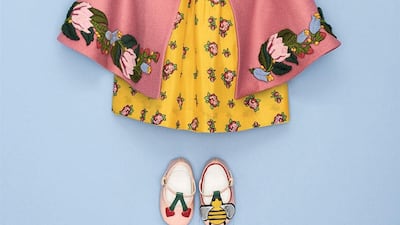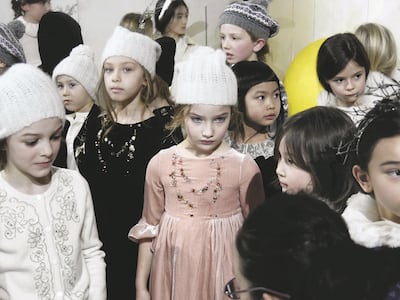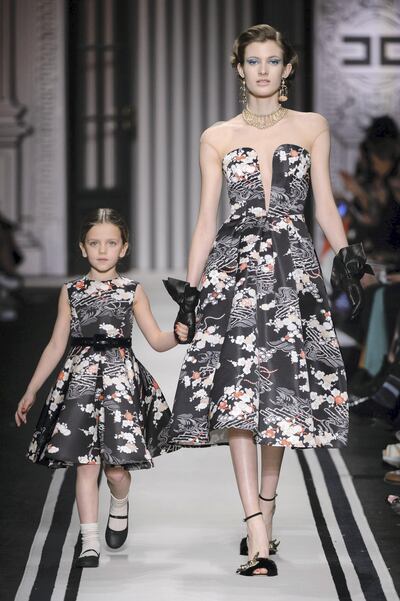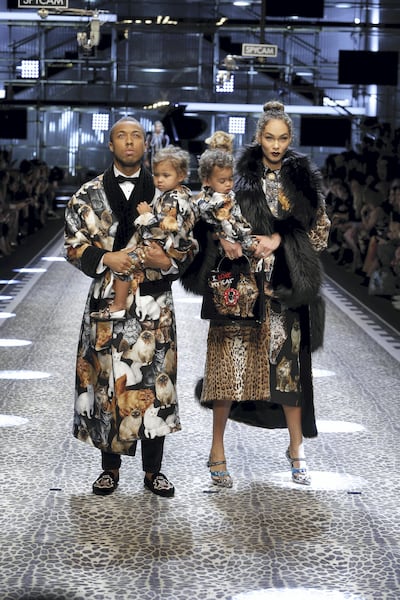It's always tough staying ahead of the fashion curve, and those wanting to stand out from the crowd this autumn/winter, are going to have to really up their accessories game, because the latest It bag or shoe du jour is no longer good enough. For those wanting to break the internet this season, the new must-have is an offspring, wearing the same outfit as you.
Welcome to the age of the mini-me.
Taking its name from Austin Powers's tiny doppelgänger, this trend for twinning with the children has been steadily building in popularity. Fuelled by celebrity parents such as Kim Kardashian and Beyoncé, coupled with a seemingly insatiable need to post our lives all over social media, more and more of us are getting matchy-matchy with the kids.
In the digital age, small clothes are big business. A report by Global Industry Analysts, entitled Children's Wear: A Global Strategic Business Report, predicts that the childrenswear market will be worth $US291 billion (Dh1.06 trillion) by the end of 2020. The report cited the increasing number of luxury labels catering to this segment as a key growth driver.
Sales of children's clothes by high-end brands, such as Dolce & Gabbana, Stella McCartney and Christian Dior, are on the rise, driven in part by what the report describes as the "growing exposure of children to media and the ensuing rise in materialism". In other words, as children spend increasing amounts of time online, their awareness of brands, and their willingness to voice an opinion on their own clothing choices, grows. And, crucially, parents seem increasingly prepared to indulge those choices, regardless of the cost.
With a business model that spans the globe, online shopping platform Farfetch.com is well placed to spot changing patterns in shopping habits. So the fact that it decided to launch a children's division in March last year is no coincidence. Increasingly, the site stocks matching outfits in both adult and children's sizes, a move that has been well received by its customers.
Read more: Tommy Hilfiger announces exclusive childrenswear collection for the GCC
As Candice Fragis, buying and merchandising director at Farfetch.com, explains: "Our customers love the mini-me factor – kids' styles that match a piece or print from a brand's ready-to-wear line are some of our most popular items. For example, we recently launched Dubai-based label Bambah's new children's range, Little Bambah, which offers 24 mini-me pieces pulled from adult collections. The designer, Maha Abdul Rasheed, launched the line in response to overwhelming demand from mothers requesting matching outfits for their little ones. I think that social media can definitely be credited with influencing this type of shopping behaviour. The popularity of our mini-me kidswear styles is likely fuelled by the allure of capturing that perfect Insta-moment."
As with every industry, fashion relies on profit margins and market expansion for continued growth. As womenswear reaches saturation point, brands are looking to move into other, less crowded segments, and childrenswear is ripe for the picking. Of course, the fact that children are literally still growing is a boon for companies, as this is an audience that is constantly in need of new things. It is also, in theory, a way of instilling brand loyalty from a very young age.
Traditionally, the majority of a child's outfits were bought by mothers, with practicality in mind, while expensive, more frivolous clothes were purchased by extended family looking to lavish attention on a child. Now, mothers are also "investing" in those high-cost items, apparently willing to spend on a child's wardrobe in the same way they spend on their own.
Always quick to follow trends, parents in the UAE are particularly comfortable spending large amounts of money dressing their children in the latest designer garments. Long known for its adult fashion offerings, Harvey Nichols – Dubai was one of the first stores to see the potential for high-end children's wear, and has stocked the likes Dolce & Gabbana Children, Fendi Kids and Kenzo Kids for several years.
As Marlène Tronel Chevalier, buyer for childrenswear at Harvey Nichols – Dubai, explains: "Childrenswear is really important in this region, and local customers usually make sure to dress their kids properly. They are sensitive to luxury brands for their little ones, especially for big occasions, such as Eid."
Read more: Kate Spade launches childrenswear in the UAE
A key trendsetter in this particular arena is Blue Ivy Carter, the 5-year-old daughter of pop royalty Beyoncé and Jay Z, who has had a sizeable effect on what is deemed acceptable attire for the under-5s. Last summer, Blue Ivy and her mother wore matching Gucci sundresses in Paris, and opted for the label again for the premiere of Beauty and the Beast earlier this year. This time they wore matching green Gucci gowns, with the young Ms Carter's dress retailing at Dh7,350. At the MTV VMA awards last year, meanwhile, Blue Ivy wore a Mischka Aoki princess dress that retails for Dh40,500, to complement her mother's Francesco Scognamiglio couture gown.
Meanwhile, Kim and Kanye West's daughter North, 4, and son Saint, 1, are already rumoured to be wearing custom-made Lagerfeld. Mind you, North was wearing child-sized Balmain long before it even existed. And last year, the then 3-year-old wore the same Vetements sequinned dress as her mother – all the more notable given that the brand's creations are notoriously hard to get hold of. More recently, to attest to the fact that age is no barrier to twinning, Gwyneth Paltrow and her 74-year-old mother Blythe Danner stepped out in matching floral Prada ensembles.
While high-end children’s clothes are hardly a new idea – Christian Dior launched its Baby Dior line back in 1969 – having small versions of adult pieces is a much newer phenomenon. When British brand Burberry launched its children’s line in 2008, it offered a scaled-down version of its adult wear. And despite being slow to join the kids’s sector, both Balmain and Givenchy’s children’s lines, when they finally arrived this year, were almost direct facsimiles of what was seen on the autumn/winter 2017 ready-
to-wear runways.
The undisputed master of childrenswear, however, has to be Dolce & Gabbana, which has elevated clothes from sartorial swag to a statement of family devotion. Promoted as an essential part of the brand's "Italian family heritage" philosophy, the brand has been building its children's line as a complement to its adult range for the past two years, when it sent dresses emblazoned with the words "I love you mamma" down the runway.
This approach climaxed on the brand's autumn/winter 2017 runway, when the show opened with the designer-model couple Jason and Amanda Harvey clutching their twins Noah and Rose, all dressed in head-to-toe matching feline prints. Far from being a flash-in-the-pan-trend, the mini-me movement seems to be gaining traction.
"The 'mini-me' trend is interesting because there is an emotional component to it – that moment of dressing up with your child is a real draw for some. Dolce & Gabbana has been very strategic with this, offering seasonal 'mini-me' printed styles that always perform well," Fragis explains.
"For example, the brand's lemon-print dresses and swimsuits sold out simultaneously on Farfetch in both women's and kids sizes. I definitely think that the luxury childrenswear market will continue to develop – the potential for growth is massive."
________________
Read more:
Limited edition childrenswear from Coach & Colette
Luxury Magazine: Beirut style, Zuhair Murad, Charlotte Tilbury and more
________________




